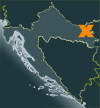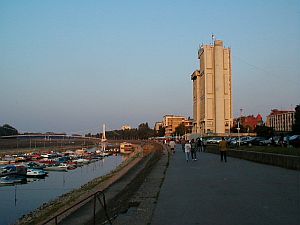|
|
|
 Name:
Osijek. The town marks the crossing point of several cultures, and so it has some other names as well. The German name is
Essegg (also Esseg), auch Esseg), to Hungarians it's known as Eszék.
Name:
Osijek. The town marks the crossing point of several cultures, and so it has some other names as well. The German name is
Essegg (also Esseg), auch Esseg), to Hungarians it's known as Eszék.
Location:
Osijek stretches along the right bank of the river Drava, which is one of the biggest tributaries of the river Danube.
The latter is only 20 km away east of the town. The area around Osijek is called East Slavonia and marks the narrow
north-east strip of the Croatia. To →Serbia in the east it's only around 20 km, to
→Bosnia & Hercegovina in the south it's less than 60 km and to
→Hungary in the north it's 35 km. The Croatian capital →Zagreb
lies west of Slavonia and is around 200 km away as the crow flies. East Slavonia is a large, fertile plain partially characterized by extensive marshland.
The border to Serbia is very interesting. Once, the meandering Danube marked the border, and so the border followed the meanderings.
During the centuries, the Danube changed it's course. The border didn't.
Population:
Around 105,000 (according to older statistics!). This makes Osijek the fourth biggest town of the country. At the beginning of the 20th century,
every fifth citizen was German. Additionally, many Serbs settled in or around Osijek. It would be interesting to
get to know about recent statistics...however, at least most of the Germans left the town many decades ago.

| |
The centre on the left bank of the river Drava
|
Orientation:
Osijek occupies a rather long but narrow strip of land along the river, which has historical reasons.
Since the left (northern) bank of the river consists of marshland and is periodically flooded, the town was built on the right bank. The railway
runs parallel to the river. The train station and the adjacent bus terminal are almost one kilometre away south of the city centre.
Everything south of the train station and the railway is industrial area. The modern centre of town is called
Gornji Grad (Upper Town), the old centre is known as Tvrđa (castle district) and lies east of the
modern centre. The distance between the two districts is surprisingly big. There are many parks in town and a pleasant riverside promenade.
However, not many historic buildings survived in Osijek. It would be an exaggeration to say that the centre of Osijek is highly interesting,
but it's worth a stopover and the surrounding area is nice.
History:
The history of Osijek already started a long time ago, when the Romans created the province of Pannonia. Therefore,
an important bridge was built in present-day Osijek. At the same time, the Romans erected a heavily fortified settlement
called Adelia Mursa, but later on the entire settlement was destroyed by the Huns.
The name Osijek itself first appeared in the year 1196. Actually, the new town was built some kilometres west of the Roman colony.
The castle district marks the oldest part of medieval Osijek. In 1526, advancing Ottoman troops invaded and destroyed the town in
order to build a new one shortly after. They'd not just built a new town but also an 8 km long wooden bridge spanning the river and
the marshland. Chronicles say that it only took three weeks to complete the structure. Thanks to the bridge, Osijek became quite
famous. Until 1687: The Austrian Habsburg monarchy 'liberated' the town and, unfortunately, destroyed the bridge. Ever since, until the
collapse of the Monarchy in 1918 as a result of WW I, Osijek remained in Austria-Hungary. The Austrian emperor ordered the colonization
of East Slavonia, and so countless Germans and Serbs settled in the area. The Germans were called
Donauschwaben (Swebians of the Danube), but almost all of them were expelled after the World War II. Since 1918,
Osijek is an important town in Croatia resp Yugoslavia. Nowadays, it's the administrative centre of the
region Osijek-Baranja. During the war between 1991-95, Osijek played a strategically important role (see below).
Getting there:
Osijek is an important transport hub and even has its own airport south-west of the centre. However, the airport was
heavily damaged during the war, and I'm not sure whether it was already reopened.
Every train from →Zagreb via →Novi Sad to
→Belgrade in →Serbia stops in Osijek. Additionally, there
are some more trains running between Osijek and Zagreb. There's another international train connecting
→Budapest with →Sarajevo which also stops in Osijek.
Another option is to take a local (and very slow) train to Beli Manastir, a quiet provincial town north of Osijek,
and then to →Pécs in south-west Hungary. This takes around three hours, the fare is 94 Kuna.
All buses start from the bus station next to the train station. Several buses run to →Vukovar. This takes
less than one hour, the return fare is 37 Kuna. There are also buses to Tuzla in northern
→Bosnia & Hercegovina. This takes up to 3-4 hours, the fare is 14 KM (€ 7).
There are even direct buses from Germany and other countries to Osijek.
Everything in Osijek is within walking distance, but there's also an efficient tram and bus network.
|